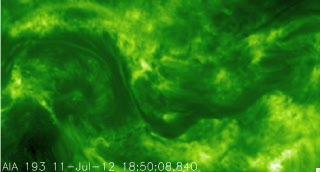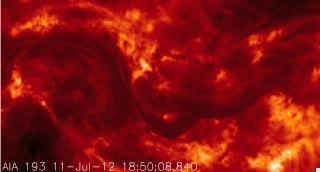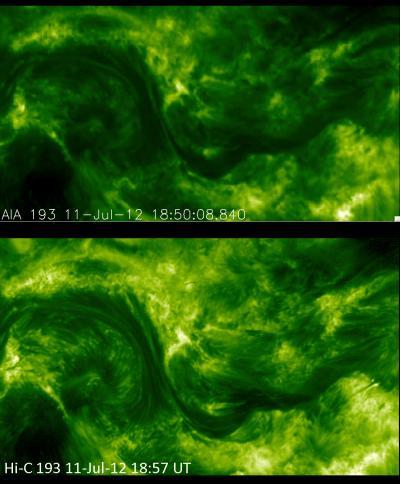reveal tangled magnetic fields channeling the solar plasma into a range of complex structures.
"We have an exceptional instrument and launched at the right time," said Jonathan Cirtain, senior heliophysicist at NASA's Marshall Space Flight Center. "Because of the intense solar activity we're seeing right now, we were able to clearly focus on a sizeable, active sunspot and achieve our imaging goals."
Since Hi-C rode on a suborbital rocket, its flight lasted for just 10 minutes. Of that time, only about 330 seconds were spent taking data. Yet those images contain a wealth of information that astronomers will analyze for months to come.
"The Hi-C flight might be the most productive five minutes I've ever spent," Golub smiled.
The high-resolution images were made possible because of a set of innovations on Hi-C's telescope, which directs light to the camera detector. The telescope includes some of the finest mirrors ever made for a space mission. Initially developed at NASA's Marshall Space Flight Center in Huntsville, Ala., the mirrors were completed with inputs from partners at the Smithsonian Astrophysical Observatory (SAO) in Cambridge, Mass., and a new manufacturing technique developed in coordination with L-3Com/Tinsley Laboratories of Richmond, Calif. The mirrors were made to reflect extreme-ultraviolet light from the Sun by Reflective X-ray Optics LLC of New York, NY, and the telescope was assembled at the SAO labs in Cambridge, Mass.

This time-lapse movie shows activity in the sun's corona on July 11, 2012, with 10 minutes compressed into 10 seconds. It begins with images from the Atmospheric Imaging Assembly (AIA) on board NASA's Solar Dynamics Observatory. About three seconds in, the view switches to super-high-resolution photos of the same region from NASA's High Resolution Coronal Imager (Hi-C). Hi-C flew on a sounding rocket and only took data for about five minutes, so the view switches back to AIA data at the end. The representative-color images were made from observations of ultraviolet light at a wavelength of 19.3 nanometers (25 times shorter than the wavelength of visible light).
(Photo Credit: NASA)

This time-lapse movie shows activity in the sun's corona on July 11, 2012, with 10 minutes compressed into 10 seconds. It begins with images from the Atmospheric Imaging Assembly (AIA) on board NASA's Solar Dynamics Observatory. About three seconds in, the view switches to super-high-resolution photos of the same region from NASA's High Resolution Coronal Imager (Hi-C). Hi-C flew on a sounding rocket and only took data for about five minutes, so the view switches back to AIA data at the end. The representative-color images were made from observations of ultraviolet light at a wavelength of 19.3 nanometers (25 times shorter than the wavelength of visible light).
(Photo Credit: NASA)

These photos of the solar corona, or million-degree outer atmosphere, show the improvement in resolution offered by NASA's High Resolution Coronal Imager, or Hi-C (bottom), versus the Atmospheric Imaging Assembly on NASA's Solar Dynamics Observatory (top). Both images show a portion of the sun's surface roughly 85,000 by 50,000 miles in size. Hi-C launched on a sounding rocket on July 11, 2012 in a flight that lasted about 10 minutes. The representative-color images were made from observations of ultraviolet light at a wavelength of 19.3 nanometers (25 times shorter than the wavelength of visible light).
(Photo Credit: NASA)